Method to Assess and Enhance Vulnerable Road User Safety during Impact Loading
Abstract
1. Introduction
2. Materials and Methods
2.1. Pedestrian Safety Regulations
- ▪
- A legform impactor representing the adult lower limb;
- ▪
- An upper legform impactor representing the adult upper leg and pelvis;
- ▪
- Child and adult headform impactors.
2.2. Cyclist Helmet Regulations
2.3. Child on Bicycle-Mounted Seat Restrain Regulations
2.4. Motorcyclist Helemet Regulations
2.5. Author’s Research Methodology
3. Results
- Norms and regulations encompassing the safety requirements for a VRU during an impact. They are formed on biomechanical criteria—often established based on empirical data—and, on the other hand, limited by technical and economic aspects.
- Experimental tests carried out according to detailed requirements for each group of VRUs, which were described in Section 2.
- Standard criteria setting out thresholds such as HIC or acceleration limits related to VRU safety—they depend solely on the time history of the translational acceleration of a head CoG and do not evaluate whole body kinematics (pedestrian) nor the crashworthiness of a safety system (a bicycle-mounted seat).
- Numerical simulations to verify the injuries/kinematics of a VRU by having an insight into VRU’s biomechanics by the use of the state-of-the-art numerical models. This tier may involve:
- 4.1
- Coupling (4.1) that is, combining more than one numerical code;
- 4.1
- Single numerical code approach for example, finite element analysis for tissue-level simulations (4.2).
- 5
- Numerical-based criteria based on biomechanical studies combined with numerical simulations and full human body analysis. This stage shall contribute in improving the biomechanical criteria in stage 1—this is highlighted by a dashed line, joining the steps 5 and 1, in Figure 10. The mechanically relevant responses related to VRU’s:
- 5.1
- Kinematics—such as the k parameter, which can determinate the geometric property of the pedestrian body movement after a collision. This criterion is thoroughly described in the author’s publication [71].
- 5.2
- Acceleration, intracranial pressure, stress and strain, which have been postulated as head injury mechanisms and thereby may be used as predictions of various head injuries.
- 6
- Technical countermeasures to enhance VRU safety when the standard (stage #3) and numerical criteria (stage #5) are not met. The author has already proposed these countermeasures for each group of VRUs:
- 6.1
- 6.2
- The multisensor headband, which can be worn under a helmet to gain the data about the VRU. The system enables registering complex dynamic characteristics of a human head during situations in which the head is exposed to mechanical impact and it is able to measure bioelectrical brain activity (electroencephalography)—patent pending [75]. The detection of the respective pathomechanism in cases of destructed brain structures is extremely important in terms of prevention and treatment.
- 6.3
- The U-protector designed to increase the safety of a child, who is transported in a bicycle-mounted seat. The attachable device helps to protect the child’s head during the impact of a vehicle or bicycle fall over [41].
- 6.4
- The motorcycle helmet made of cork, where the padding is made of agglomerated cork or cork composite (agglomerated cork joined with expanded cork). The cork material improves the overall performance and capacity to withstand multi-impacts comparing to the standard synthetic padding. The device was introduced and evaluated in References [76,77].
4. Discussion
Limitations of the Study
5. Conclusions
Funding
References
- European Parliament and Council. Directive on the Framework of Deployment of ITS in the Field of Road Transport and for Interfaces with Other Modes of Transport; European Parliament and Council: Brussels, Belgium, 2010. [Google Scholar]
- SWOV. Fact sheet Vulnerable road users; SWOV: The Hague, The Netherlands, 2012; pp. 1–5. [Google Scholar]
- Ptak, M.; Konarzewski, K. Numerical Technologies for Vulnerable Road User Safety Enhancement. In New Contributions in Information Systems and Technologies; Springer: Cham, Switzerland, 2015; Volume 354, pp. 355–364. ISBN 9783319165271. [Google Scholar]
- Simms, C.; Wood, D. Pedestrian and Cyclist Impact; Solid Mechanics and Its Applications; Springer Netherlands: Dordrecht, The Netherlands, 2009; Volume 166, ISBN 978-90-481-2742-9. [Google Scholar]
- European Commission. Smart, green and integrated transport. Horizon 2020—Work Program; European Commission: Brussels, Belgium, 2018. [Google Scholar]
- World Health Organization. Global Status Report on Road Safety 2018; World Health Organization: Geneva, Switzerland, 2018; ISBN 978-92-4-156568-4. [Google Scholar]
- WHO. Fact Sheet N0 358; Report; World Health Organization: Geneva, Switzerland, 2013. [Google Scholar]
- Santacreu, A. Safer City Streets: Global Benchmarking for Urban Road Safety; OECD Publ.: Paris, France, 2018. [Google Scholar]
- European Commission. Road Safety in the European Union—Trends, Statistics and Main Challenges; European Commission: Brussels, Belgium, 2015. [Google Scholar]
- Jamroz, K.; Budzyński, M.; Romanowska, A.; Żukowska, J.; Oskarbski, J.; Kustra, W. Experiences and Challenges in Fatality Reduction on Polish Roads. Sustainability 2019, 11, 959. [Google Scholar] [CrossRef]
- Fernandes, F.A.O.; Alves de Sousa, R.J.; Ptak, M. Application of Numerical Methods for Accident Reconstruction and Forensic Analysis. In Head Injury Simulation in Road Traffic Accidents; Springer: Cham, Switzerland, 2018; pp. 59–98. [Google Scholar]
- World Health Organization. Global Status Report on Road Safety; Inj. Prev.; World Health Organization: Geneva, Switzerland, 2015; p. 318. [Google Scholar]
- Harper, W.W. The physical circumstances of auto-pedestrian collisions. Ariz. Med. 1958, 15, 266–272. [Google Scholar] [PubMed]
- McClain, J.G. Automobile—Pedestrian Traffic Injuries and Fatalities. Willamette Law J. 1959, 1, 514. [Google Scholar]
- Fisher, A.; Hall, R. The influence of car frontal design on pedestrian accident trauma. Accid. Anal. Prev. 1971, 4, 47–58. [Google Scholar] [CrossRef]
- Hu, J.; Klinich, K.D. Toward Designing Pedestrian-Friendly Vehicles; University of Michigan Transportation Research Institute: Ann Arbor, MI, USA, 2012. [Google Scholar]
- Shi, L.; Han, Y.; Huang, H.; He, W.; Wang, F.; Wang, B. Effects of vehicle front-end safety countermeasures on pedestrian head injury risk during ground impact. Proc. Inst. Mech. Eng. Part D J. Automob. Eng. 2019. [Google Scholar] [CrossRef]
- Sokolovskij, E.; Prentkovskis, O. Investigating traffic accidents: The interaction between a motor vehicle and a pedestrian. Transport 2013, 28, 302–312. [Google Scholar] [CrossRef]
- Han, Y.; Li, Q.; Qian, Y.; Zhou, D.; Svensson, M. Comparison of the landing kinematics of pedestrians and cyclists during ground impact determined from vehicle collision video records. Int. J. Veh. Saf. 2018, 10, 212. [Google Scholar] [CrossRef]
- Euro-NCAP European New Car Assesment Programme (Euro NCAP). Pedestrian Testin Protocol; Euro NCAP: Brussels, Belgium, 2015; p. 52. [Google Scholar]
- Daniel, S. The Role of the Vehicle Front End in Pedestrian Impact Protection; SAE Tech. Pap. 820246; SAE: Warrendale, PA, USA, 1982. [Google Scholar]
- Jarrett, K.L.; Saul, R.A. Pedestrian Injury—Analysis of the PCDS Field Collision Data. In Proceedings of the International Technical Conference on the Enhanced Safety of Vehicles, Windsor, ON, Canada, 31 May–4 June 1998; pp. 1204–1211. [Google Scholar]
- European Enhanced Vehilce-Safety Committee. EEVC Workng Group 22—Virtual Testing; European Enhanced Vehilce-Safety Committee: Brussels, Belgium, 2007. [Google Scholar]
- European Parliament and Council. Regulation (EC) no 78/2009 of The European Parliament and of the Council; European Parliament and Council: Brussels, Belgium, 2009. [Google Scholar]
- European Union Commission. Regulation (EC) No 631/2009; European Union Commission: Brussels, Belgium, 2009. [Google Scholar]
- Ptak, M.; Karliński, J. Pedestrian passive safety during the SUV impact: Regulations vs. reality. In Proceedings of the 2012 IRCOBI Conference, Dublin, Ireland, 12–14 September 2012; pp. 103–113. [Google Scholar]
- Ptak, M.; Rusiński, E.; Karliński, J.; Dragan, S. Evaluation of kinematics of SUV to pedestrian impact—Lower leg impactor and dummy approach. Arch. Civ. Mech. Eng. 2012, 12, 68–73. [Google Scholar] [CrossRef]
- Biernat, E.; Buchholtz, S.; Bartkiewicz, P. Motivations and barriers to bicycle commuting: Lessons from Poland. Transp. Res. Part F Traffic Psychol. Behav. 2018, 55, 492–502. [Google Scholar] [CrossRef]
- Otte, D.; Haasper, C. Technical parameters and mechanism for the injury risk of the knee joint of vulnerable road users impacted by cars and road traffic accidents. In Proceedings of the IRCOBI Conference, Prague, Czech Republic, 21–23 September 2005. [Google Scholar]
- Melo, N.; Berg, R.J.; Inaba, K. Injuries sustained by bicyclists. Trauma 2014, 16, 183–188. [Google Scholar] [CrossRef]
- Radziszewski, L. Bicycle Helmets (Kaski Rowerowe); Kielce, Poland, 2015; ISBN 9788363792381. (In Polish) [Google Scholar]
- Powell, E.; Tanz, R. Tykes and Bikes, Injuries associated with bicycle-towed child trailers and bicycles-mounted child seats. Arch. Pediatr. Adolesc. Med. 2000, 154, 351–353. [Google Scholar] [CrossRef] [PubMed]
- Austroads. The Australian National Cycling Strategy 2011–2016: Gearing up for Active and Sustainable Communities; Austroads: Sydney, Australia, 2010; ISBN 9781921709296. [Google Scholar]
- Oxley, J.; O’Hern, S.; Raftery, S.; Woolley, J. How safe are children when transported by bicycle? Traffic Inj. Prev. 2016, 17, 163–167. [Google Scholar] [CrossRef] [PubMed]
- Jakobsson, L.; Isaksson-Hellman, I.; Lundell, B. Safety for the growing child: Experiences from Swedish accident data. In Proceedings of the 19th International Technical Conference on the Enhanced Safety of Vehicles, Washington, DC, USA, 6–9 June 2005. [Google Scholar]
- Baranowski, P.; Damaziak, K.; Malachowski, J.; Mazurkiewicz, L.; Muszyński, A. A child seat numerical model validation in the static and dynamic work conditions. Arch. Civ. Mech. Eng. 2015, 15, 361–375. [Google Scholar] [CrossRef]
- Mazurkiewicz, L.; Baranowski, P.; Karimi, H.R.; Damaziak, K.; Malachowski, J.; Muszynski, A.; Muszynski, A.; Robbersmyr, K.G.; Vangi, D. Improved child-resistant system for better side impact protection. Int. J. Adv. Manuf. Technol. 2018, 97, 3925–3935. [Google Scholar] [CrossRef]
- Ptak, M.; Wilhelm, J.; Saunders, N. Safety analysis of a bicycle-mounted child seat. In Proceedings of the IEEE 2018 XI International Science-Technical Conference Automotive Safety, Casta, Slovakia, 18–20 April 2018; pp. 1–6. [Google Scholar]
- Tanz, R.R.; Christoffel, K.K. Tykes on bike: Injuries associated with bicycle-mounted child seats. Pediatr. Emerg. Care 1991, 7, 297–301. [Google Scholar] [CrossRef] [PubMed]
- European Committee for Standardization. DIN EN 14344: Child Seats for Cycles—Safety Requirements and Test Methods; European Committee for Standardization: Brussels, Belgium, 2004. [Google Scholar]
- Ptak, M.; Wilhelm, J.; Sawicki, M.; Rusiński, E. Child safety on various bicycle-mounted seats during vehicle impact. Transport 2019, 34. in-print. [Google Scholar]
- United Nations Economic Commission for Europe (UNECE). Motorcycle Helmets Riders’ Guide to Protective Helmets; United Nations Economic Commission for Europe (UNECE): Geneva, Switzerland, 2015. [Google Scholar]
- Fernandes, F.A.O.; de Sousa, R.J.A. Finite element analysis of helmeted oblique impacts and head injury evaluation with a commercial road helmet. Struct. Eng. Mech. 2013, 48, 661–679. [Google Scholar] [CrossRef]
- Belytschko, T.B.; Andriacchi, T.P.; Schultz, A.B.; Galante, J.O. Analog studies of forces in the human spine: Computational techniques. J. Biomech. 1973, 6, 361–371. [Google Scholar] [CrossRef]
- Cafolla, D.; Marco, C. Design and Simulation of Humanoid Spine. In Mechanisms and Machine Science; Springer: Cham, Switzerland, 2015; pp. 585–593. [Google Scholar]
- Cafolla, D.; Chen, I.-M.; Ceccarelli, M. An experimental characterization of human torso motion. Front. Mech. Eng. 2015, 10, 311–325. [Google Scholar] [CrossRef]
- Arkusz, K.; Klekiel, T.; Sławiński, G.; Będziński, R. Influence of energy absorbers on Malgaigne fracture mechanism in lumbar-pelvic system under vertical impact load. Comput. Methods Biomech. Biomed. Eng. 2019, 1–11. [Google Scholar] [CrossRef] [PubMed]
- Fernandes, F.A.O.; Alves De Sousa, R.J. Motorcycle helmets—A state of the art review. Accid. Anal. Prev. 2013, 56, 1–21. [Google Scholar] [CrossRef] [PubMed]
- Compagne, J. MAIDS: Motorcycle Accidents in-Depth Study; ITF: Lillehammer, Norway, 2008. [Google Scholar]
- Ptak, M.; Kaczyński, P.; Fernandes, F.; de Sousa, R.A. Computer Simulations for Head Injuries Verification After Impact. In Lecture Notes in Mechanical Engineering; Rusiński, E., Pietrusiak, D., Eds.; Springer International Publishing: Cham, Switzerland, 2017; Volume Part F10. [Google Scholar]
- Ratajczak, M.; Będziński, R. An investigation of brain structure deformations under impact loading. In Proceedings of the International Conference of the Polish Society of Biomechanics—Biomechanics 2014, Łódź, Poland, 1–3 September 2014; pp. 183–184. [Google Scholar]
- Nikodem, A.; Pezowicz, C.; Filipiak, J.; Piątek, A.; Biezyński, J.; Kiełbowicz, Z. Effect of bisphosphonate on mechanical and structural properties of trabecular bone. J. Biomech. 2012, 45, S548. [Google Scholar] [CrossRef]
- Matsui, Y.; Oikawa, S. Effect of Seat Condition on Abdominal Injuries to Vehicle Occupants in Frontal Impact Accidents. Appl. Sci. 2018, 8, 2047. [Google Scholar] [CrossRef]
- Karliński, J.; Rusiński, E.; Smolnicki, T. Protective structures for construction and mining machine operators. Autom. Constr. 2008, 17, 232–244. [Google Scholar] [CrossRef]
- Karliński, J.; Ptak, M.; Działak, P.; Rusiński, E. The approach to mining safety improvement: Accident analysis of an underground machine operator. Arch. Civ. Mech. Eng. 2016, 16, 503–512. [Google Scholar] [CrossRef]
- Derlukiewicz, D.; Karliński, J.; Iluk, A. The Operator Protective Structures Testing for Mining Machines. Solid State Phenom. 2010, 165, 256–261. [Google Scholar] [CrossRef]
- Joszko, K.; Wolański, W.; Burkacki, M.; Suchoń, S.; Zielonka, K.; Muszyński, A.; Gzik, M. Biomechanical analysis of injuries of rally driver with head supporting device. Acta Bioeng. Biomech. 2016, 18, 159–169. [Google Scholar] [PubMed]
- Karliński, J.; Ptak, M.; Działak, P. Improving occupant safety in heavy goods vehicles-Universal energy absorbing system. In Proceedings of the 11th International Science and Technical Conference Automotive Safety, AUTOMOTIVE SAFETY 2018, Casta, Slovakia, 18–20 April 2018. [Google Scholar]
- Fernandes, F.A.O.; Jardin, R.T.; Pereira, A.B.; Alves de Sousa, R.J. Comparing the mechanical performance of synthetic and natural cellular materials. Mater. Des. 2015, 82, 335–341. [Google Scholar] [CrossRef]
- Ptak, M.; Kaczyński, P.; Wilhelm, J.; Margarido, J.M.T.; Marques, P.A.A.P.; Pinto, S.C.; de Sousa, R.J.A.; Fernandes, F.A.O. Graphene-Enriched Agglomerated Cork Material and Its Behaviour under Quasi-Static and Dynamic Loading. Materials 2019, 12, 151. [Google Scholar] [CrossRef] [PubMed]
- Wilhelm, J.; Ptak, M.; Rusiński, E. Simulated depiction of head and brain injuries in the context of cellularbased materials in passive safety devices. Sci. J. Marit. Univ. Szczecin 2017, 50, 98–104. [Google Scholar]
- Miller, K. Biomechanics of the Brain; Miller, K., Ed.; Biological and Medical Physics, Biomedical Engineering; Springer Science & Business Media: New York, NY, USA, 2011; ISBN 1441999973. [Google Scholar]
- King, A.I.; Yang, K.H.; Zhang, L.; Hardy, W. Is head injury caused by linear or angular acceleration? In Proceedings of the IRCOBI Conference, Lisbon, Portugal, 25–26 September 2003; pp. 1–12. [Google Scholar]
- Fernandes, F.A.O.; Tchepel, D.; Alves de Sousa, R.J.; Ptak, M. Development and validation of a new finite element human head model: Yet another head model (YEAHM). Eng. Comput. (Swansea, Wales) 2018, 35, 477–496. [Google Scholar] [CrossRef]
- Ratajczak, M.; Ptak, M.; Chybowski, L.; Gawdzińska, K.; Będziński, R. Material and Structural Modeling Aspects of Brain Tissue Deformation under Dynamic Loads. Materials 2019, 12, 271. [Google Scholar] [CrossRef] [PubMed]
- Ptak, M.; Ratajczak, M.; Kwiatkowski, A.; Sawicki, M.; Wilhelm, J.; Fernandesa, F.A.O.; Druszcz, A. Investigation of biomechanics of skull structures damages caused by dynamic loads. Acta Bioeng. Biomech. 2019, 21. [Google Scholar] [CrossRef]
- King, A.I. The Biomechanics of Impact Injury; Springer: Cham, Switzerland, 2018; ISBN 978-3-319-49790-7. [Google Scholar]
- Li, G.; Wang, F.; Otte, D.; Cai, Z.; Simms, C. Have pedestrian subsystem tests improved passenger car front shape? Accid. Anal. Prev. 2018, 115, 143–150. [Google Scholar] [CrossRef] [PubMed]
- Chen, H.; Poulard, D.; Forman, J.; Crandall, J.; Panzer, M.B. Evaluation of geometrically personalized THUMS pedestrian model response against sedan–pedestrian PMHS impact test data. Traffic Inj. Prev. 2018, 19, 542–548. [Google Scholar] [CrossRef] [PubMed]
- Li, X.; Kleiven, S. Improved safety standards are needed to better protect younger children at playgrounds. Sci. Rep. 2018, 8, 15061. [Google Scholar] [CrossRef] [PubMed]
- Ptak, M. Pedestrian safety: A new method to assess pedestrian kinematics. Transport 2018, 33, 41–51. [Google Scholar] [CrossRef]
- Ptak, M.; Blicharski, P.; Rusiński, E.; Karliński, J. Numerical Simulations of Composite Frontal Protection System According to EC 78/2009. Lect. Notes Mech. Eng. 2017, Part F10, 423–429. [Google Scholar]
- Ptak, M.; Kaczynski, P.; Fernandes, F.A.O.; de Sousa, R.J.A. Assessing impact velocity and temperature effects on crashworthiness properties of cork material. Int. J. Impact Eng. 2017, 106, 238–248. [Google Scholar] [CrossRef]
- Ptak, M.; Rusiński, E.; Karliński, J. Frontal Protection System for pedestrian safety. Patent 399762 PL 2012. [Google Scholar]
- Ptak, M.; Sawicki, M.; Wilhelm, J.; Wnuk, M.; Ratajczak, M.; Fernandes, F.A.O.; Kwiatkowski, A.; Kubicki, K. Multisensor Headband. Patent pending - P.426323 2018. [Google Scholar]
- Kaczyński, P.; Ptak, M.; Fernandes, F.A.O.; Chybowski, L.; Wilhelm, J.; de Sousa, R.J.A. Development and testing of advanced cork composite sandwiches for energy-absorbing structures. Materials 2019, 12, 697. [Google Scholar] [CrossRef] [PubMed]
- Fernandes, F.; Alves de Sousa, R.; Ptak, M.; Migueis, G. Helmet Design Based on the Optimization of Biocomposite Energy-Absorbing Liners under Multi-Impact Loading. Appl. Sci. 2019, 9, 735. [Google Scholar] [CrossRef]
- LLC Elemance Global Human Body Models Consortium. User Man. M50 Occupant Version 4.2 LS-DYNA, 2014.
- Fernandes, F.A.O.; Sousa, R.J.A.D. Head injury predictors in sports trauma—A state-of-the-art review. Proc. Inst. Mech. Eng. Part H J. Eng. Med. 2015, 229, 592–608. [Google Scholar] [CrossRef] [PubMed]
- Tse, K.M.; Lim, S.P.; Tan, V.B.C.; Lee, H.P. A Review of Head Injury and Finite Element Head Models. Am. J. Eng. Technol. Soc. 2015, 1, 28. [Google Scholar]
- Katagiri, M.; Katagata, K.; Pramudita, J.A.; Ujihashi, S. Development and Application of Stress-Based Skull Fracture Criteria Using a Head Finite Element Model. J. Biomech. Sci. Eng. 2012, 7, 449–462. [Google Scholar] [CrossRef]
- Takhounts, E.G.; Craig, M.J.; Moorhouse, K.; McFadden, J.; Hasija, V. Development of brain injury criteria (BrIC). Stapp Car Crash J. 2013, 57, 243. [Google Scholar] [PubMed]
- Milne, G.; Deck, C.; Bourdet, N.; Alline, Q.; Gallego, A.; Carreira, R.P.; Willinger, R. Assessment of Bicyclist Head Injury Risk under Tangential Impact Conditions. In Proceedings of the IRC-13-90 IRCOBI Conference 2013, Gothenburg, Sweden, 11–13 September 2013; Volume 33, pp. 735–746. [Google Scholar]
- Migueis, G.F.J.; Fernandes, F.A.O.; Ptak, M.; Ratajczak, M.; Alves de Sousa, R.J. Detection of bridging veins rupture and subdural haematoma onset using a finite element head model. Clin. Biomech. 2019, 63, 104–111. [Google Scholar] [CrossRef] [PubMed]
- United Nations. ECE Regulation 22.05, 2002. Uniform Provision Concerning the Approval of Protective Hel- Mets and Their Visors for Driver and Passengers of mOtor Cycles and Mopeds; United Nations: New York, NY, USA, 2002. [Google Scholar]
- Shuaeib, F.M.; Hamouda, A.M.S.; Radin Umar, R.S.; Hamdan, M.M.; Hashmi, M.S.J. Motorcycle helmet - Part I. Biomechanics and computational issues. J. Mater. Process. Technol. 2002, 123, 406–421. [Google Scholar] [CrossRef]
- Kleiven, S. Finite Element Modeling of the Human Head. Med. Biol. 2002, 12, 14–21. [Google Scholar]
- Fernandes, F.A.O. Análise Biomecânica de Impactos com Capacetes: Novos Materiais e Geometrias, Biomechanical Analysis of Helmeted Head Impacts: Novel Materials and Geometries; Universidade de Aveiro: Aveiro, Portugal, 2017. [Google Scholar]
- Ratajczak, M.; Sąsiadek, M.; Będziński, R. An analysis of the effect of impact loading on the destruction of vascular structures in the brain. Acta Bioeng. Biomech. 2016, 18, 21–31. [Google Scholar] [PubMed]
- Kumar, S.; Friedman, K.; Hutchinson, J.; Mihora, D.; Harcourt, J. Biomechanical analysis of child restraint system. Biomed. Sci. Instrum. 2009, 45, 436–441. [Google Scholar] [PubMed]
- Klinich, K.D.; Saul, R.A.; Auguste, G.; Backaitis, S.; Klienberger, M. Techniques for Developing Child Dummy Protection Reference Values; National Highway Traffic Safety Administration: Washington, DC, USA, 1996.

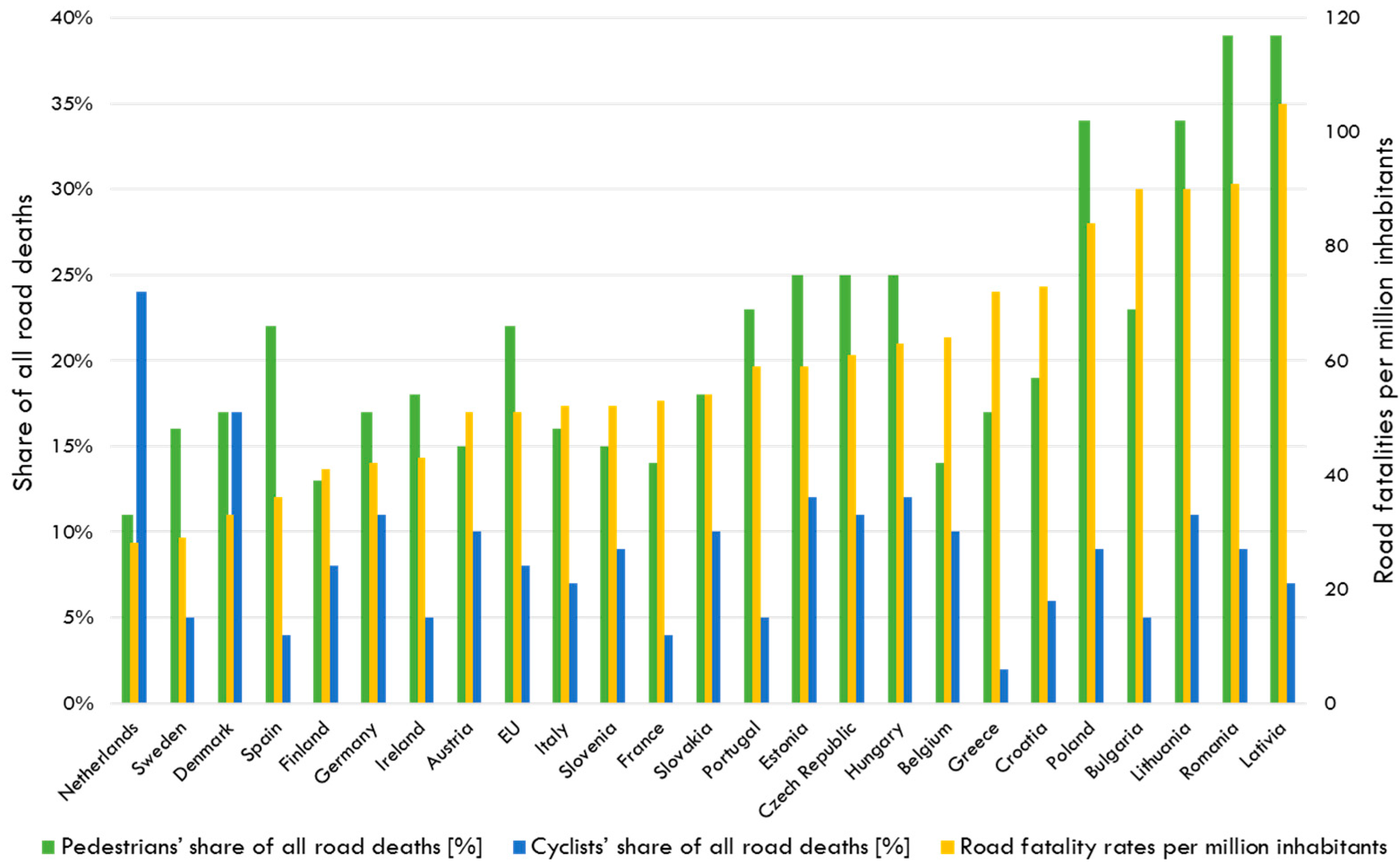
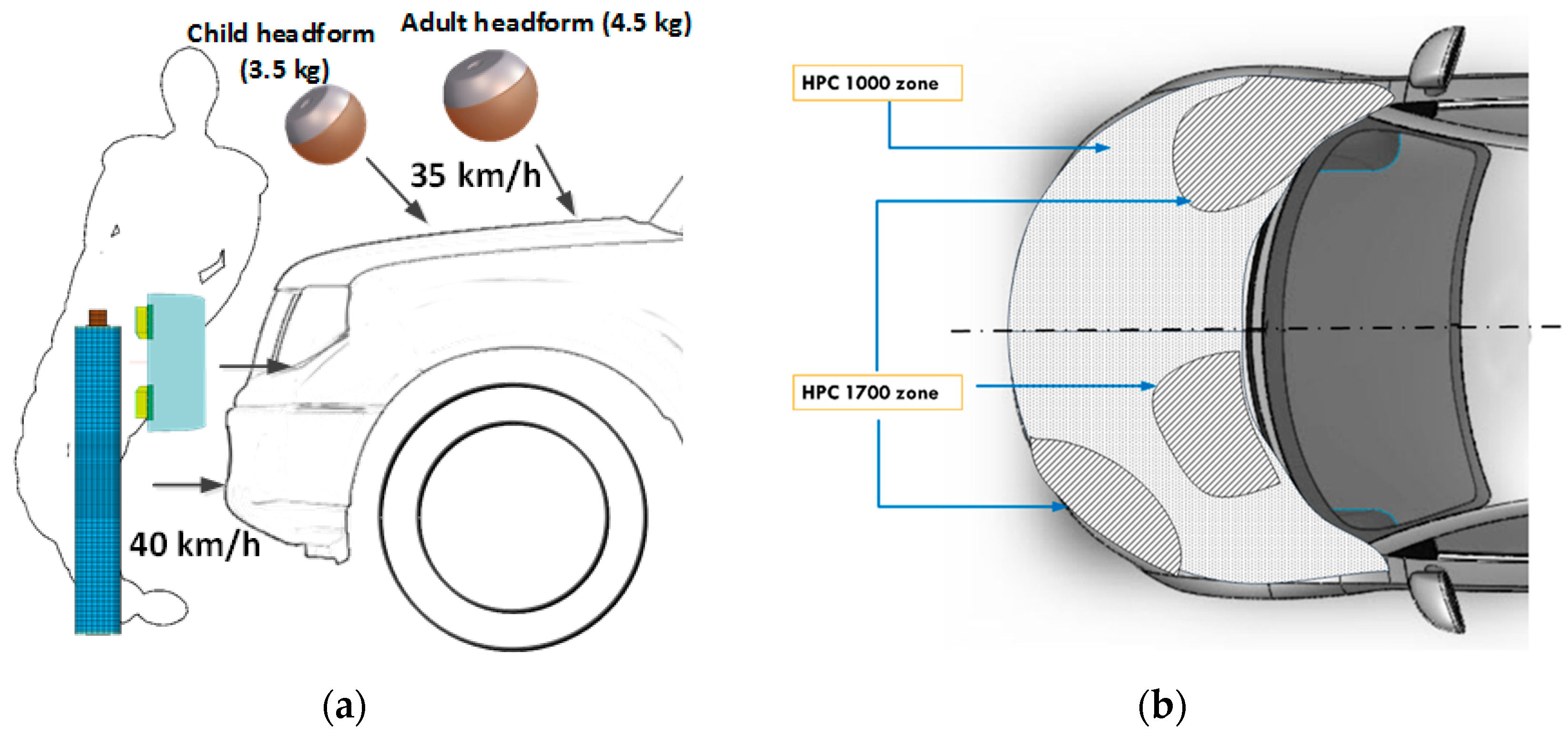
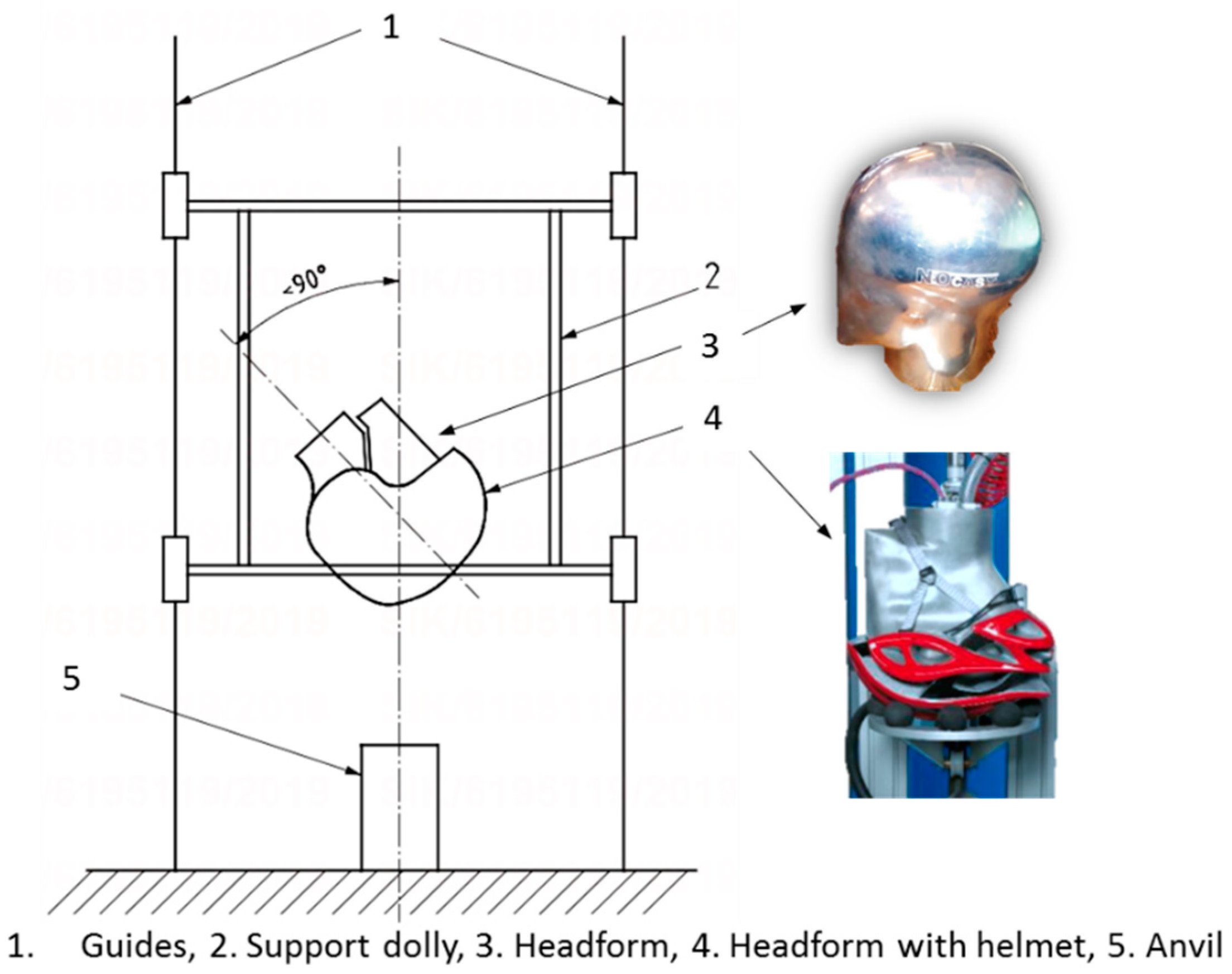

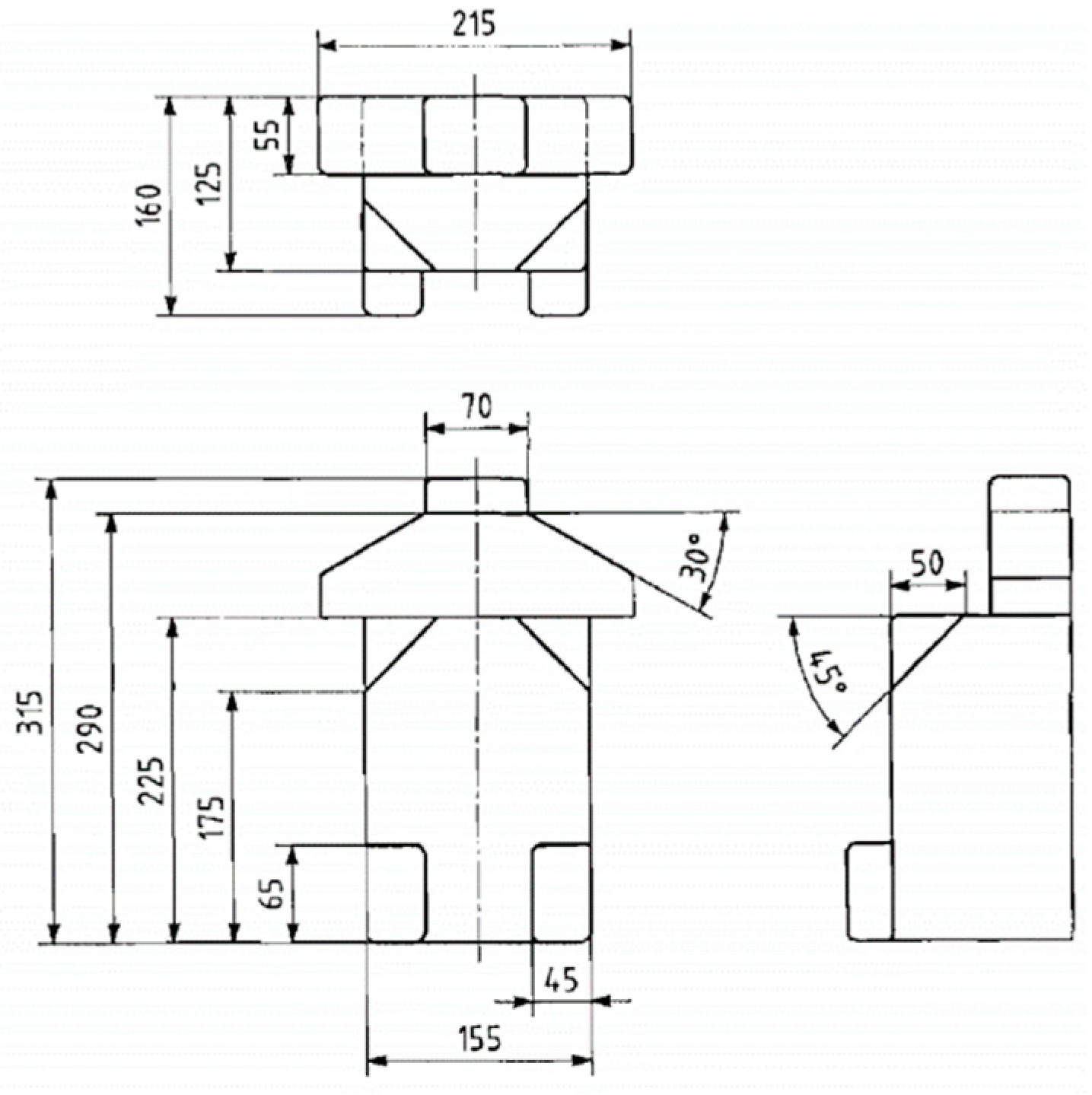
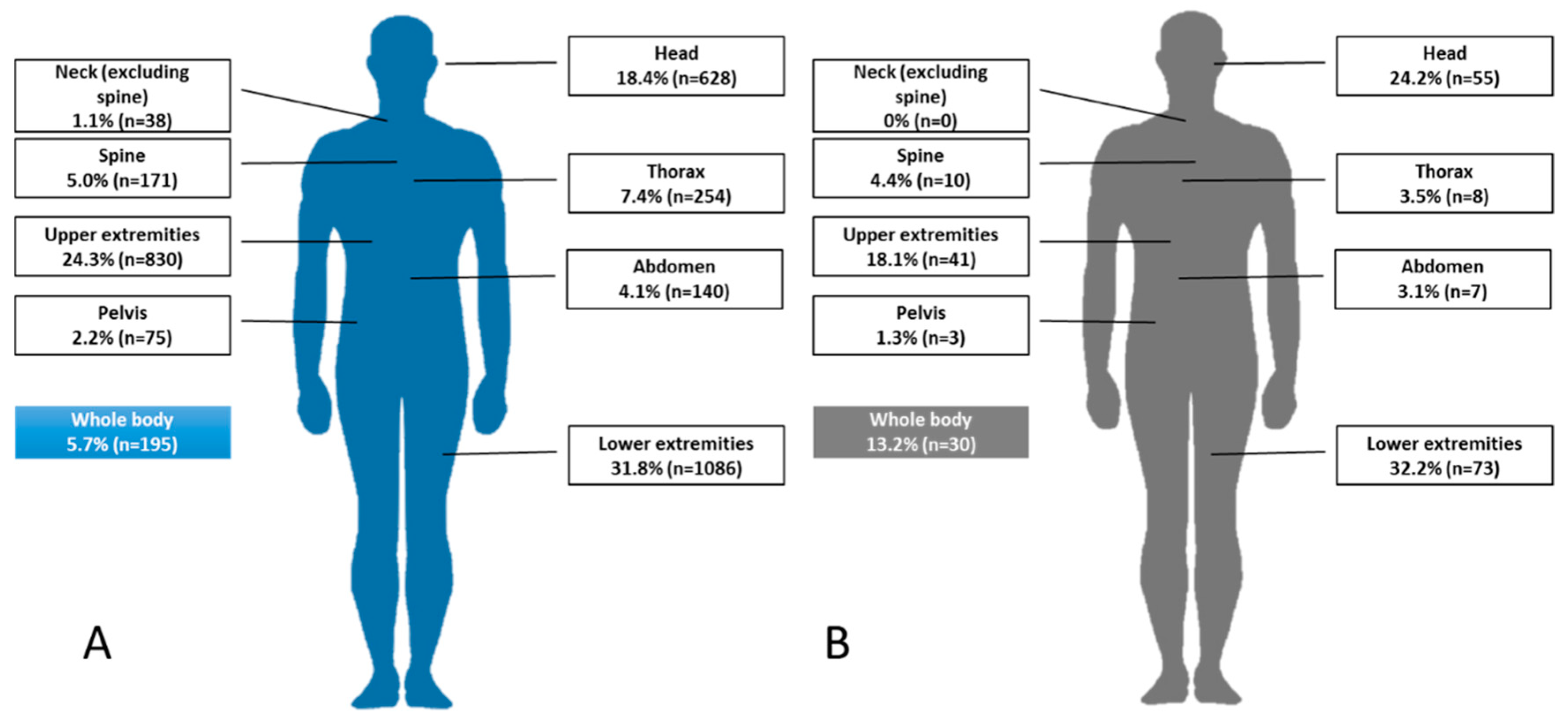
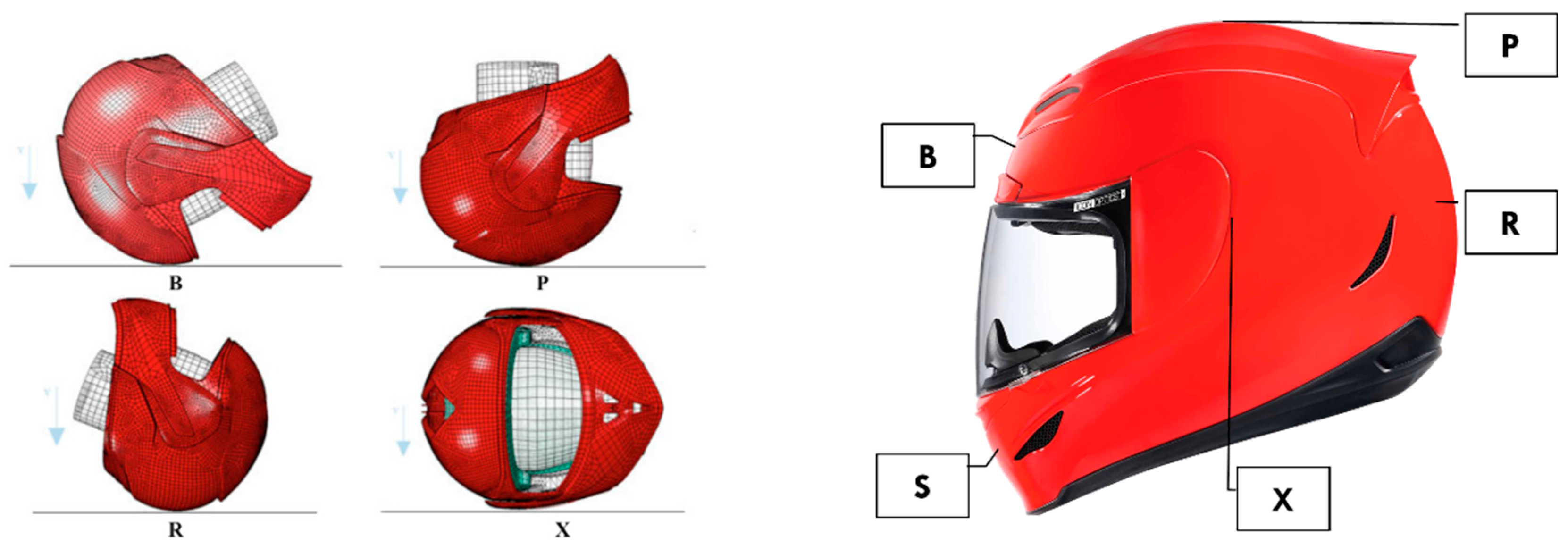

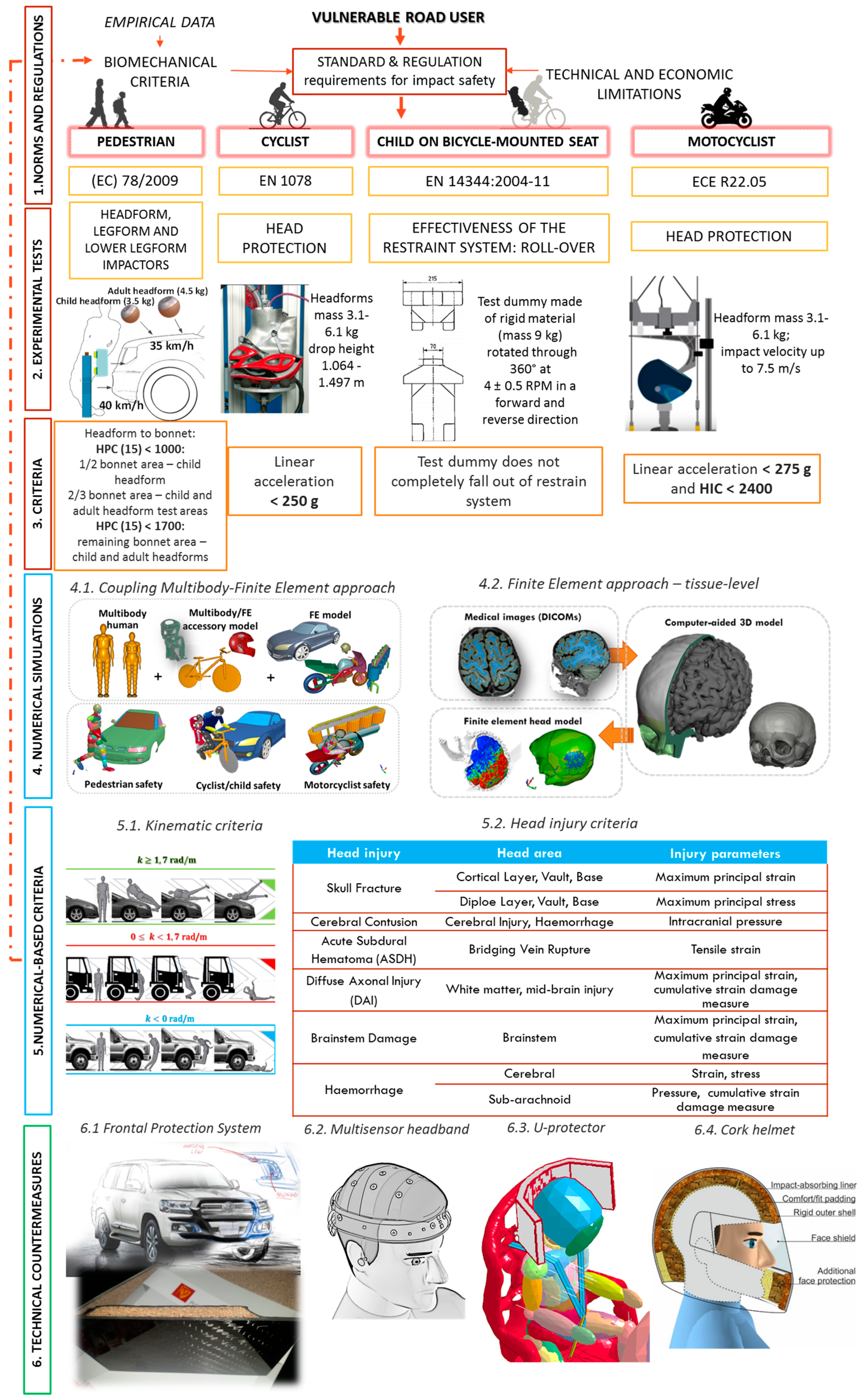
| Body Region | Frequency [%] |
|---|---|
| Head | 42 |
| Neck | 6 |
| Thorax | 21 |
| Upper extremity | 44 |
| Abdomen | 5 |
| Pelvis | 11 |
| Thigh | 7 |
| Knee | 25 |
| Lower leg | 15 |
| Foot | 13 |
| VRU Case Study | Numerical Approach | In-Depth Numerical Study |
|---|---|---|
| Pedestrian accident—windshield impact at 72 km/h. The sustained injuries in brain tissues are assessed to be critical—cerebral contusion. | 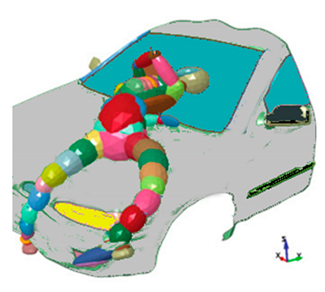 50th-percentile male MB pedestrian model coupled with a FE compact car. | 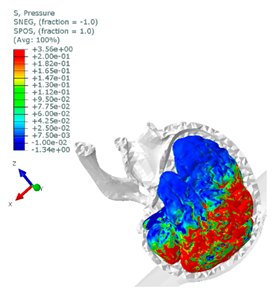 Hydrostatic pressure in the brain [MPa]. |
| Cyclist accident—SUV impacts at 40 km/h. Skull fractures can be clearly validated during autopsy or CT medical examination. Research important for cyclist’s helmet optimization and forensic science. | 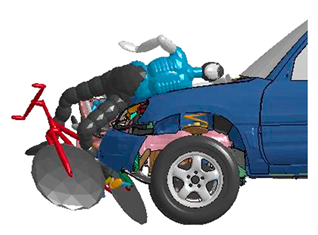 50th-percentile male on a MB bicycle model, coupled with a FE SUV. | 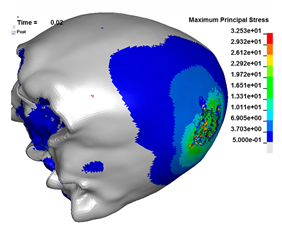 Cyclist’s skull—max principal stress and fracture pattern on periosteum and endosteum [MPa]. |
| Child on bicycle-mounted seat—compact car impacts at 40 km/h. The child slips out from seat belts and impacts the bonnet. The child’s seat crashworthiness is assessed. | 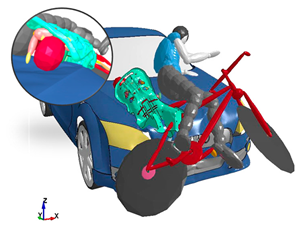 50th-percentile male and 1.5-year-old child MB models coupled with a FE SUV—the head bonnet contact magnified. | 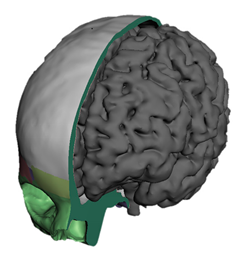 Child’s head numerical model. |
| Motorcyclist—the helmet test according to ECE R22.05 (point B) with an advanced head model to compare HIC registered on the standard headform with cerebral pressure on FE model. |  EN 960 headform test published in Reference [50] (left): HIC = 1876 and amax = 213 g vs. the helmet with advanced head model (right—sagittal section through the head and helmet). | 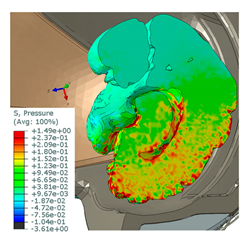 Hydrostatic pressure in the brain [MPa]—sagittal section view, left hemisphere visible. |
| Head Injury | Criteria | Threshold |
|---|---|---|
| Bone (skull) fracture | Maximum principal stress (diploe layer) | 20 MPa |
| Maximum principal strain (cortical layer) | 0.42% | |
| Bone (facial/nose) fracture | Effective plastic strain (cortical layer) | 1.2% |
| Effective plastic strain (trabecular layer) | 4.5% | |
| Acute Subdural Hematoma (ASDH) | Strain in bridging veins. ASDH due to bridging vein rupture. | 25% |
| Cerebral contusion | Intracranial pressure in region of interest (Coup) | 237 kPa |
| Intracranial pressure in region of interest (Contrecoup) | −104 kPa | |
| Diffuse axonal injury | Average maximum principal strain in ROI | 48% |
© 2019 by the author. Licensee MDPI, Basel, Switzerland. This article is an open access article distributed under the terms and conditions of the Creative Commons Attribution (CC BY) license (http://creativecommons.org/licenses/by/4.0/).
Share and Cite
Ptak, M. Method to Assess and Enhance Vulnerable Road User Safety during Impact Loading. Appl. Sci. 2019, 9, 1000. https://doi.org/10.3390/app9051000
Ptak M. Method to Assess and Enhance Vulnerable Road User Safety during Impact Loading. Applied Sciences. 2019; 9(5):1000. https://doi.org/10.3390/app9051000
Chicago/Turabian StylePtak, Mariusz. 2019. "Method to Assess and Enhance Vulnerable Road User Safety during Impact Loading" Applied Sciences 9, no. 5: 1000. https://doi.org/10.3390/app9051000
APA StylePtak, M. (2019). Method to Assess and Enhance Vulnerable Road User Safety during Impact Loading. Applied Sciences, 9(5), 1000. https://doi.org/10.3390/app9051000






